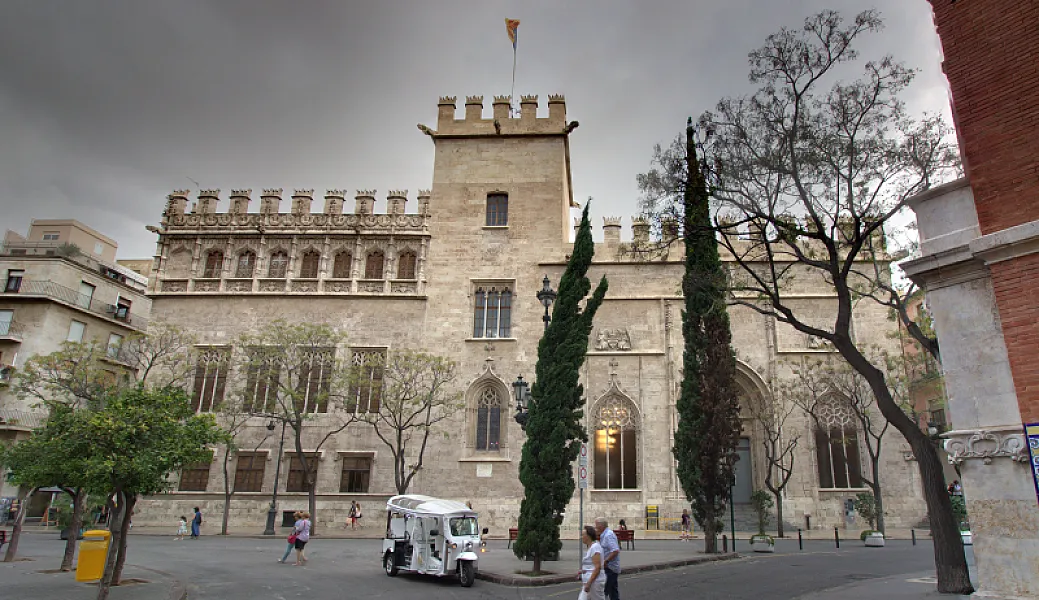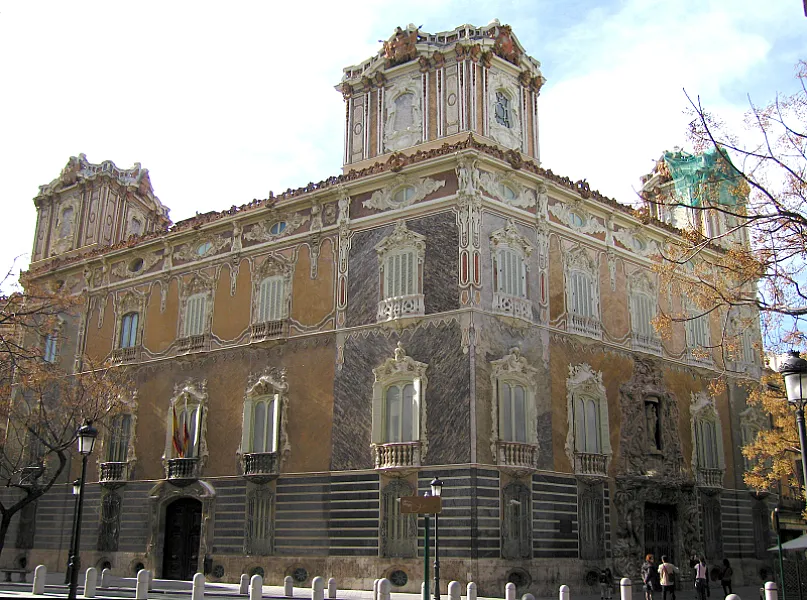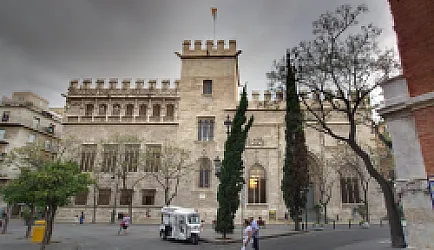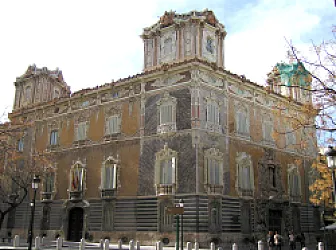Visitez Valence en 2 jours
8 POIs incontournables, parcours optimisés et anecdotes.
Chargement de la carte...
Vous allez visiter les plus beaux points d'intérêt de Valence
2 Days in Valencia — A First-Timer's Love Letter to the City
Valencia stole my heart the moment I stepped into its warm light and tangled streets. Known for the City of Arts and Sciences and as the birthplace of paella, Valencia feels alive in a soft, sunlit way. Some say it's overrated, but I promise the city rewards curiosity. I visited alone one spring, and every corner surprised me with texture, color, and kindness.
Why visit? Because Valencia blends bold history with everyday life. The air smells faintly of orange blossom and frying rice. You can hear tram bells, laughter from terraces, and the hush inside gothic halls. In this short guide I'll point you to Llotja de la Seda, the ornate Palace of the Marqués de Dos Aguas, and the intimate charm of Ateneo Mercantil de Valencia. If you're wondering what to see in Valencia, expect sun-warmed stone, intricate carvings, and neighborhoods where time slows. You will feel both energized and gently soothed.
Planning can be overwhelming. There is so much to see that you could spend weeks wandering. If this is your first time in Valencia, deciding what to prioritize feels hard. I get it — you want the highlights without rushing. That’s why this Valencia itinerary focuses on four unforgettable spots. Below, I'll show you exactly how to spend 2 days in Valencia to get the best mix of landmark, historic architecture, and palace visits.
Key tip: Go early to major sites to beat the crowds and enjoy the best light. Mornings give you calmer rooms, cooler walks, and clearer photos. This small habit transforms busy sightseeing into slow discovery. Pack comfortable shoes and leave a little room for spontaneous cafés and alleyway detours. Now let's dive into the itinerary!

Quick Mini Guide to Valencia
Where to stay:
- Ciutat Vella — base for Llotja de la Seda and Archbishop's Palace; walkable historic streets and morning market life.
- Eixample / Gran Vía — close to Palace of the Marqués de Dos Aguas and Ateneo Mercantil, lots of modernist architecture and cafés.
- Near Turia Gardens — if you prefer quick access to green routes linking the main sights on foot or by bike.
When to visit:
- Spring and autumn for mild weather; mornings best for Llotja and cathedral precinct to avoid tour groups.
- March = Las Fallas (spectacular but extremely crowded); plan and book well in advance if you want that experience.
Things to do:
- Visit Llotja de la Seda — buy timed tickets; admire the late-Gothic silk exchange hall and carved columns.
- See Palace of the Marqués de Dos Aguas — focus on the rococo façade and ceramics collection inside.
- Check opening hours for Archbishop's Palace; combine with Valencia Cathedral circuit for the historic core.
- Drop into Ateneo Mercantil — catch a talk, exhibition or rooftop view; it's a civic hub with local cultural life.
- Book an interactive city tour: The Walter Case VALENCIA or The Alchemist VALENCIA for immersive local storytelling.
Don't forget:
- Try horchata with fartons near the central market; a true Valencian ritual.
- Wear comfortable shoes for cobblestones and a lightweight layer for breezy evenings by Turia Gardens.
- Reserve tickets for key sites and evening tours in advance; many openings are limited.
Jour 1 - Valence
4 POIs à découvrirJour 1 - Matin à Valence
4 Points d'intérêt - Durée : 3h00 - Distance : 1 km - Marche : 0h12
Lonja de la seda
- La Lonja de la Seda ou Lonja de los Mercaderes est un chef-d'œuvre de l'architecture civile gothique valencienne.◾ Construite entre 1470 et 1471, elle a été conçue par Francesc Baldomar et achevée par ses disciples Joan Ivarra et Pere Compte.
- La Lonja a été déclarée patrimoine mondial de l'humanité par l'Unesco en 1996.
- La structure a été modelée sur la Lonja de Palma de Majorque et symbolise la richesse de l'âge d'or de Valence et la révolution commerciale de la fin du Moyen Âge.
- Le bâtiment sert de symbole de prospérité commerciale, car il a été construit à une époque où Valence était confrontée à des bouleversements économiques dus à la découverte de l'Amérique.
- La valeur du bâtiment a été estimée entre 350 et 400 millions d'euros.

Ateneo Mercantil de Valencia
- El Ateneo Mercantil de València : institution culturelle fondée le 23 mars 1879 dans le Colegio de Santo Pablo de València.
- Créé par Estanislao García Monfort et d'autres disciples d'Eduardo Pérez Pujol pour répondre aux besoins culturels et de formation des vendeurs de magasins de València.
- Elle devint une importante association de la bourgeoisie marchande, promouvant les écoles de commerce et parrainant la création de la Chambre de commerce de Valence et d'autres institutions.
- Le président Tomás Trénor Palavicino fut l'un des organisateurs de l'Exposition régionale de Valence de 1909.
- Pendant la guerre civile espagnole, il était connu sous le nom d'Ateneo Popular Valenciano, contrôlé par le secteur de même esprit dans la Seconde République espagnole.
- Interdit de 1939 à 1950, il reprit ses activités en 1950.
- Il reçoit la médaille de la ville de Valence en 1960 et est déclaré entité d'utilité publique en 1970.

Palais du Marqués de Dos Aguas
- Le palais du Marqués de Dos Aguas aurait été à l'origine le site d'une nécropole romaine datant du Ier au IIIe siècle de notre ère.
- Le bâtiment accueille aujourd'hui le Musée national de la céramique et des arts somptuaires González Martí, suite à une rénovation radicale du manoir gothique d'origine.
- La rénovation a inclus des éléments ornementaux, s'éloignant du caractère sévère de l'ancien manoir, avec la collaboration du peintre Hipólito Rovira, du sculpteur Ignacio Vergara et du décorateur Luis Domingo.
- Le bâtiment est de forme carrée irrégulière avec une cour centrale et des tours aux angles.
- Ses façades sont hautes de deux étages, avec une entrée principale en albâtre où figure une image de la Vierge du Rosaire.
- Entre 1853 et 1867, une nouvelle rénovation a eu lieu, supprimant les fresques existantes en raison des dommages causés par l'humidité et les remplaçant par des stucs imitant les marbres ; les balcons ont également été redessinés.En 1941, le palais a été déclaré monument historique et artistique.
- Il a été acheté par l'État en 1949 pour abriter la collection de céramiques offerte par Manuel González Martí et, après rénovation, a été ouvert en tant que musée en 1954.

Palais archiépiscopal de Valence
- Le Palacio Arzobispal est la résidence de l'archevêque de Valence.
- Le bâtiment actuel, de style baroque historiciste, date d'une reconstruction après la guerre civile espagnole et a été achevé en 1946.
- La conception et l'exécution du palais ont été gérées par l'architecte Vicente Traver, avec Federico Ferrando Tena comme constructeur.⏳ Les origines du palais remontent à la vente de quelques maisons par Jaime Ier d'Aragon, qui se trouvaient en face de l'église Santa María.
- Le palais abritait autrefois une grande bibliothèque fondée en 1758, ainsi qu'une collection numismatique, des sculptures anciennes et des peintures de grande valeur.
- Le palais a été incendié pendant la guerre civile espagnole en 1936 et n'a été démoli qu'en 1940, un nouveau palais ayant été construit à sa place entre 1941 et 1946.
Jour 2 - Valence
4 POIs à découvrirJour 2 - Matin à Valence
4 Points d'intérêt - Durée : 3h00 - Distance : 1 km - Marche : 0h12
Lonja de la seda
- La Lonja de la Seda ou Lonja de los Mercaderes est un chef-d'œuvre de l'architecture civile gothique valencienne.◾ Construite entre 1470 et 1471, elle a été conçue par Francesc Baldomar et achevée par ses disciples Joan Ivarra et Pere Compte.
- La Lonja a été déclarée patrimoine mondial de l'humanité par l'Unesco en 1996.
- La structure a été modelée sur la Lonja de Palma de Majorque et symbolise la richesse de l'âge d'or de Valence et la révolution commerciale de la fin du Moyen Âge.
- Le bâtiment sert de symbole de prospérité commerciale, car il a été construit à une époque où Valence était confrontée à des bouleversements économiques dus à la découverte de l'Amérique.
- La valeur du bâtiment a été estimée entre 350 et 400 millions d'euros.

Ateneo Mercantil de Valencia
- El Ateneo Mercantil de València : institution culturelle fondée le 23 mars 1879 dans le Colegio de Santo Pablo de València.
- Créé par Estanislao García Monfort et d'autres disciples d'Eduardo Pérez Pujol pour répondre aux besoins culturels et de formation des vendeurs de magasins de València.
- Elle devint une importante association de la bourgeoisie marchande, promouvant les écoles de commerce et parrainant la création de la Chambre de commerce de Valence et d'autres institutions.
- Le président Tomás Trénor Palavicino fut l'un des organisateurs de l'Exposition régionale de Valence de 1909.
- Pendant la guerre civile espagnole, il était connu sous le nom d'Ateneo Popular Valenciano, contrôlé par le secteur de même esprit dans la Seconde République espagnole.
- Interdit de 1939 à 1950, il reprit ses activités en 1950.
- Il reçoit la médaille de la ville de Valence en 1960 et est déclaré entité d'utilité publique en 1970.

Palais du Marqués de Dos Aguas
- Le palais du Marqués de Dos Aguas aurait été à l'origine le site d'une nécropole romaine datant du Ier au IIIe siècle de notre ère.
- Le bâtiment accueille aujourd'hui le Musée national de la céramique et des arts somptuaires González Martí, suite à une rénovation radicale du manoir gothique d'origine.
- La rénovation a inclus des éléments ornementaux, s'éloignant du caractère sévère de l'ancien manoir, avec la collaboration du peintre Hipólito Rovira, du sculpteur Ignacio Vergara et du décorateur Luis Domingo.
- Le bâtiment est de forme carrée irrégulière avec une cour centrale et des tours aux angles.
- Ses façades sont hautes de deux étages, avec une entrée principale en albâtre où figure une image de la Vierge du Rosaire.
- Entre 1853 et 1867, une nouvelle rénovation a eu lieu, supprimant les fresques existantes en raison des dommages causés par l'humidité et les remplaçant par des stucs imitant les marbres ; les balcons ont également été redessinés.En 1941, le palais a été déclaré monument historique et artistique.
- Il a été acheté par l'État en 1949 pour abriter la collection de céramiques offerte par Manuel González Martí et, après rénovation, a été ouvert en tant que musée en 1954.

Palais archiépiscopal de Valence
- Le Palacio Arzobispal est la résidence de l'archevêque de Valence.
- Le bâtiment actuel, de style baroque historiciste, date d'une reconstruction après la guerre civile espagnole et a été achevé en 1946.
- La conception et l'exécution du palais ont été gérées par l'architecte Vicente Traver, avec Federico Ferrando Tena comme constructeur.⏳ Les origines du palais remontent à la vente de quelques maisons par Jaime Ier d'Aragon, qui se trouvaient en face de l'église Santa María.
- Le palais abritait autrefois une grande bibliothèque fondée en 1758, ainsi qu'une collection numismatique, des sculptures anciennes et des peintures de grande valeur.
- Le palais a été incendié pendant la guerre civile espagnole en 1936 et n'a été démoli qu'en 1940, un nouveau palais ayant été construit à sa place entre 1941 et 1946.
Where to Stay in Valencia
Location matters a lot in Valencia because the city is compact and most of the sights you’ll want to see—the Llotja de la Seda, the Cathedral and the Archbishop's Palace of Valencia, the civic heart around the Ateneo Mercantil de Valencia—sit within or just beside the historic core. For a two‑day visit you’ll get the most out of your time if you base yourself where you can walk to several monuments and step out for tapas without losing hours to transfers.
The city is organized around the old medieval centre and the long green ribbon of the Turia gardens, with the financial and shopping grid of the Eixample and the lively, more bohemian pockets like Ruzafa a short walk away. Understanding that split helps: the compact old town is where the monuments cluster, the Eixample and avenues lead to transport hubs and the Turia park provides a calm, linear landmark you’ll cross frequently when sightseeing.
If you want to be closest to the Llotja de la Seda and the Cathedral and prefer wandering narrow streets, aim for the Ciutat Vella neighbourhood, especially around El Carmen and La Seu. For easy access to the Palace of the Marqués de Dos Aguas and the cultural institutions near the Plaza del Ayuntamiento, choose the adjacent Eixample area where streets are broader and cafés open earlier. If you enjoy a lively food and bar scene with a short walk to the museums, the colourful Ruzafa district is a great alternative that still keeps the old town within 15–20 minutes on foot.
Transport tips are simple: Valencia’s metro and buses are reliable and the airport connects to the centre by metro lines, but for a two‑day stay you’ll mostly walk or take short taxi rides. Pick accommodation near a metro stop or the Estació del Nord/Joaquín Sorolla if you arrive by train. The Turia gardens make walking between districts pleasant and fast—use them as your orientation line.
For reassurance: prioritise quiet streets over a room that faces a busy plaza if you value sleep, and consider small guesthouses or apartments for a local feel. Whatever you choose, basing yourself in or just beside the historic centre gives you maximum sightseeing time, minimal stress, and easy access to the city’s best bites and cultural treasures.
Getting Around Valencia
Valencia is a joy to explore because the city’s transport is compact, well-signed and tourist-friendly — you’ll quickly get the hang of it. The backbone is Metrovalencia (a mix of metro and tram lines) complemented by frequent EMT buses and longer-distance Cercanías trains. Stations and stops are close to major sights, ticket machines have an English option, and many drivers and ticket agents speak a bit of English, so even if it’s your first time using a European system you’ll feel comfortable. Short walks between attractions are often the fastest way to soak in the city vibe 🚇.
Practical tip: decide early whether you want single rides or passes. A single ticket works fine for one-off hops, but if you plan several journeys buy a reusable 10-ride card (locally known as the Bonometro) or a day pass at machines, kiosks or EMT points. Many buses and stations accept contactless bank cards and mobile payments, which is the fastest option if you don’t want to fiddle with cash. Keep your ticket until the end of the journey — inspectors do pop up now and then 🎫.
Use Google Maps like a local: type your destination and pick the transit icon to see step-by-step combinations of walking, tram, metro or bus with real-time departure times. If you prefer fewer transfers, tap the route options to prioritize walking or fewer line changes. I always save a screenshot of the last connection if I’m heading somewhere with patchy signal, and Maps’ “depart at” feature is brilliant for planning museum visits around train times.
To save money, combine walking with public transport. The historic centre is delightfully walkable, so you might only need a short tram or bus trip once a day. If you’re sightseeing heavily, consider the Valencia Tourist Card which bundles unlimited public transport with discounts to museums and attractions. Small choices — taking a tram one stop, sharing a 10-ride card with a travel partner — add up over a few days 💡.
On my first visit I loved how easy a day was: we strolled from the Llotja de la Seda through the atmospheric streets to the Ateneo Mercantil de Valencia in under ten minutes, enjoying café windows and people-watching at Plaza del Ayuntamiento. When a sudden shower hit, we hopped on an EMT bus with contactless payment and were off to the Palace of the Marqués de Dos Aguas in minutes — no stress, no queue, just quick shelter and a new museum to explore. You’ll find Valencia’s transport makes exploring relaxed and adventurous at the same time.
What to Pack for Valencia
Valencia is a strollable city of golden plazas, ornate palaces and surprising corners — I once walked 15 miles in a day chasing tiles and viewpoints — so packing smart beats packing heavy. Below are the essentials I always bring when I’m wandering between the Plaza de la Virgen, the Silk Exchange and the futuristic City of Arts and Sciences. Each item has a quick why and a tiny anecdote so you know when it saved me.
1. Comfortable walking shoes (required — e.g., New Balance 574 or ECCO Soft 7): Valencia’s cobbles and palace steps demand shoes with cushion and grip. I wore stiff trainers once and my feet rebelled by hour six; switch to a cushioned pair like New Balance 574 and you can easily be out for 10+ hours without limping. Why: prevents blisters, supports long days of wandering between landmarks.
2. Cross-body bag: I prefer a zippered, anti-theft cross-body that sits in front — Mercado Central and tourist plazas get crowded and I’ve seen people distracted while someone tried to unzip a tote. Why: keeps essentials accessible and safe, leaves hands free for photos and tasting horchata.
3. Weather-appropriate clothing for Valencia: Think light layers: breathable tee, a thin cardigan or light windbreaker for evenings, and a hat. Once I underestimated the late-afternoon sea breeze and a thin jacket saved me on a rooftop terrace. Why: Mediterranean sun + coastal breeze means warm days but cooler nights; layers keep you comfortable from morning to a sunset paseo.
4. Power adapter (Type C/E, 230V): Spanish sockets use two round pins — I forgot an adapter once and couldn’t charge my camera until the hostel front desk lent me one. Why: ensures you can plug in hotel chargers, hair tools, or camera batteries without hunting for replacements.
5. Power bank (10,000–20,000 mAh): I map my routes, take photos and use offline guides; by day’s end my phone used to die. A 10,000–20,000 mAh bank kept me topped up through a long day of photos and navigation. Why: keeps GPS, camera and e-tickets running when you’re out 8–12 hours exploring.
6. Small refillable water bottle & sunscreen (optional but highly recommended): I refill at cafés and fountains — staying hydrated mattered on a sunny plaza bench. Sunscreen saved a forehead after an unexpected sunny afternoon. Why: Valencia’s sun is strong; hydration and protection keep you comfortable and happy while you admire the architecture.
Profitez de votre voyage à Valence !
Voilà un itinéraire de 2 jours, rempli de découvertes et d’émotions : 4 étapes soigneusement choisies, du charme gothique de la Llotja de la Seda au faste du Palace of the Marqués de Dos Aguas, sans oublier l’élégance de l’Archbishop's Palace of Valencia. C’est un parcours compact mais complet, avec tout ce dont vous avez besoin pour goûter l’essence de Valence.
Rappelez‑vous que ce guide est là pour vous inspirer, pas pour vous stresser : laissez de la place à l'imprévu. La magie arrive souvent lorsque vous vous perdez volontairement dans une ruelle, tombez sur une terrasse de café ou découvrez un petit musée inattendu. Ne cherchez pas à tout voir ; mieux vaut savourer que courir. Soyez flexible, laissez-vous surprendre et accordez‑vous des pauses.
Je suis vraiment enthousiaste pour vous : vous allez créer des souvenirs inoubliables en flânant entre palais, places et marchés. J’espère que chaque coin de rue vous donnera envie de revenir, et que vous repartirez avec une vraie impression de Valence dans le cœur.
Envie d’une exploration ludique ? Essayez les tours Coddy — The Walter Case VALENCIA ou The Alchemist VALENCIA — pour une façon gamifiée et amusante de découvrir la ville. Checkez ces options si vous voulez pimenter votre balade sans pression.
Bon voyage ! Amusez‑vous bien, profitez à fond et n’hésitez pas à partager vos anecdotes ou à poser des questions avant de partir.
Envie de plus d'aventure ?
Découvrez nos jeux d'évasion urbains pour transformer votre visite en aventure interactive !

















